A Precise Solution for Male Fertility and Pain
Varicoceles are a common condition that affect up to 15% of men and are found in about 40% of men with infertility. Fortunately, there’s a highly effective and minimally invasive surgical option available: microscopic varicocelectomy.
This advanced procedure is designed to treat varicoceles with maximum precision and minimal disruption—improving fertility outcomes and reducing testicular pain for many men.
What Is a Varicocele?
A varicocele is an enlargement of the veins within the scrotum, similar to varicose veins in the legs. This occurs when valves inside the veins malfunction, allowing blood to pool and cause swelling.
Common symptoms include:
A dull ache or heaviness in the scrotum
Noticeable enlarged veins (a “bag of worms” appearance)
Shrinking of the affected testicle (testicular atrophy)
Infertility or poor semen quality
Varicoceles typically occur on the left side but can affect both sides in some cases.
What Is Microscopic Varicocelectomy?
Microscopic varicocelectomy is a surgical procedure to repair varicoceles using a high-powered surgical microscope. This technique allows the surgeon to precisely identify and tie off the problematic veins while preserving important structures. This approach leads to better outcomes and fewer complications compared to older surgical methods.
Why Choose Microscopic Varicocelectomy?
- Improves Male Fertility
- Relieves Discomfort
- Lower recurrence rates (less than 1%)
- Better protection of the testicular artery
- Fewer risks of hydrocele (fluid buildup)
Frequently asked questions
Microscopic varicocelectomy is considered the gold standard in varicocele repair. It’s a safe, effective, and precise procedure that can significantly improve quality of life and fertility for many men.
If you’ve been diagnosed with a varicocele and are struggling with pain or infertility, don’t hesitate to seek a consultation. The sooner treatment begins, the better the potential outcomes.
Recovery is usually quick and straightforward:
Back to light activities: Within 2–3 days
Return to work: After about 1 week (depending on your job)
Resume exercise and sexual activity: After 2–4 weeks (ask your doctor for guidance)
You may experience mild pain or swelling for a few days, which can be managed with over-the-counter pain medication and supportive underwear.
Fertility improvements may be seen within 3 to 6 months after surgery, as sperm production cycles normalize.
This procedure is often recommended if you:
Have a clinically significant varicocele
Experience infertility with abnormal semen parameters
Have persistent scrotal pain not relieved by other means
Want to preserve or improve fertility before pursuing assisted reproductive techniques (like IVF)
If you’re unsure, a urologist specializing in male fertility can help determine whether this surgery is the best option for your goals.
While rare, possible issues include:
Hydrocele (fluid buildup, <1% risk due to lymphatic preservation).
Recurrence (1-2%).
Testicular artery injury (minimized by microscope use).
Infection or bleeding (uncommon with proper technique).
